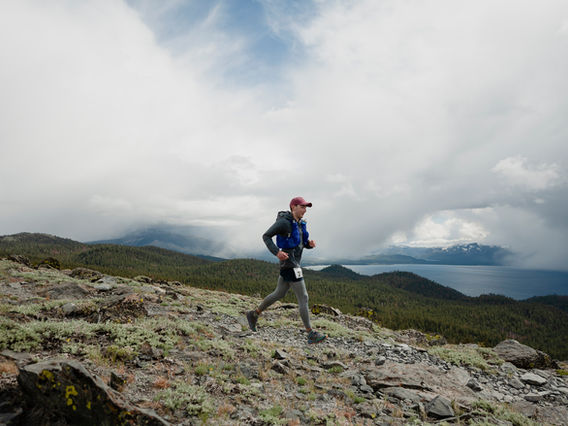I wrapped up the Mogollon Monster 100 mile ultramarathon (The Mogollon Monster 100 is a rugged, 18000 feet of climbing, challenging trail race, which requires qualification) in the small town of Pine, Arizona.
Running 100 miles is something that I would have never even deemed possible a few years ago at the age of 22, heck even a year ago. I’ve always been someone who is addicted to the process, the process of putting in consistent effort day-by-day where you don’t see any immediate results, but over a few weeks, months, years you can see all of your hard work pay off. The process is what gets me excited.
Race week: I don’t usually look forward to a taper as it means very little running, which can be difficult after the extent of the weekly miles needed for a 100-mile race. However, I know tapers are necessary and extremely beneficial to perform your best. I spent this week focusing on recovery, hydration, and getting in quality nutrition. I headed to Pine, Arizona a few days before the race to settle in and ensure that everything was ready for race day – drop bags, crew instructions, navigation, etc. Around this time I also began carb loading for the race by shifting around 70% of my caloric intake to easily digestible carbs (sweet potatoes, rice, white bread). Since Pine is also higher in altitude (around 6k feet) and hotter than what I’m used to, I also ensured that my electrolyte balance was topped off and that I was drinking a lot of water.
Friday before the race: Kept everything very similar to race week. I did a short 20-minute shakeout run in the morning and then took it easy the rest of the day. I consumed my last meal around 5 pm (chicken, rice, and salsa) in order for it to be out of my system for the 6 am start. I made sure everything was prepped for the morning, including drop-bags, pre-race meal, and necessary items for my crew so that I could get some extra sleep without worrying about packing anything in the morning.
Race morning: Given the 6 am start time for the race and a 45-minute shuttle to the race start, I woke up at 3:30 am to give myself enough time to eat my pre-race meal and drink a coffee. This meal consisted of two eggs, plain bagel, and a banana with peanut butter/honey. After this, I hopped on one of the school buses that took us to the start of the Mogollon Monster. The start of the race was high energy and everyone was in good spirits. The race organization, Arivapa running does a great job of putting on this race and there’s a great culture amongst all the volunteers. After playing the national anthem and having a guest appearance from “the monster” we hit the trails.
Start of the race: The race started off very slow as we ventured on some nice single track and entered into a Congo line. However, this was probably a good thing as it forced me to ease into the race and not go out too hard, something that I have a hard time not doing. This first climb was by far the easiest climb of the day and the nicest terrain. I made it to the top of the rim in time to enjoy incredible views of the sunrise before making our first descent. One thing to note about the race and its terrain is that the top of the rim tends to have a really fun, flat, dirt trail, but is quite the opposite when it comes to the climbing and descents.
First 40ish miles: I opted to not carry poles with me at the start of the race as they were something I had not trained with and only wanted to use them if necessary as I thought they would be more of a nuisance than anything. After enduring a few very technical, steep, loose soil, and rocky climbs/descents I decided to pick up my poles from crew at the mile 26 aid station. I ended up carrying the poles with me throughout the majority of the race. Despite not having poles to start, I was feeling pretty good. The weather was fairly mild (mid-70s) and most of the run was shaded with the large pine trees. I stuck to my nutrition plan of one spring energy every half hour and alternated this with half a cliff bar to ensure I was eating a little as often as possible. I also made sure I was staying hydrated and topping off on electrolytes. Later in the race, at aid stations, I would often add in additional solid foods whether that be potatoes, chips, pickles, or some PB&Js.
Post Myrtle climb (mile 42.5): This climb is definitely one of the most difficult ones of the race as you’re treading through waist-high grass on a rocky trail in the heat of the day. However, once you make it to the top of the rim, you’re rewarded with 15 miles or so of the nicest terrain of the race. Here, I was able to make up some time from the tough climbs earlier on.
100k mark: I made it to the 100k mark feeling pretty good given the tough first half of the race. However, as I headed from Washington Park to Geronimo (mile 70) I hit my lowest point of the race and the thought of having to stop early came into my mind. At this point, it was completely dark, I knew I would have no one pacing me throughout the night, and I felt light-headed and nauseous coming into the Geronimo aid station. Immediately, I collapsed into a chair feeling extremely sick. Both of my big toes were jacked up from the rocky terrain and every step I felt a pounding sensation. There were a few other people next to me who I heard telling the aid station volunteers they were going to DNF. My brain was definitely telling me to do the same, but I quickly realized none of the pain I had was an injury. I asked the aid station volunteer if she had any recommendations to get rid of the nausea and light-headedness and she told me to drink lots of water to flush out my system in order to basically restart from ground-zero. Since I was well ahead of the cut-offs, she told me to take a nap and then start adding back in nutrition after. This aid station had cots under a tent which felt like a 5-star hotel at this point in the race. I think I could’ve slept there all night. After taking a quick nap and pounding water beforehand, I was able to use the restroom a few times and flush out my system. I eventually started fueling back up with some broth and potatoes which helped as well. I probably spent an hour at this aid station, but I think this saved my race. Even though I wasn’t moving fast at all coming out of the station and I still wasn’t feeling anywhere near perfect, I kept moving.
Mile 85: First time seeing crew since the previous day: After making it through the night without any crew/pacers and being able to watch the most beautiful sunrise over the mountains, I was able to reunite with my crew. The last two climbs were, in my opinion, the toughest of the race because on Sunday there was zero cloud coverage and each climb was very exposed with more rocky terrain. After finishing the last climb and having 10 miles left, I knew I was at the final stretch and even got a second wind. I still had quite a bit of nausea but was feeling much better than the night portion of the race. The pancakes at mile 90 tasted amazing and gave me a second wind for the last 10 miles. I crossed the finish line in a little over 34 hours.
Overall, this was by far the toughest thing I’ve ever done. Besides a few banged-up toenails (lost two toenails), my body is feeling pretty good after this race. I definitely have quite a bit of residual fatigue—still feeling a little light-headed and nauseous but getting better day by day. Highly recommend this race to anyone wanting a tough, scenic and well-organized race.
______________________________________________________________________________________________________________________
As we reflect on the demanding yet exhilarating journey of the Mogollon Monster 100, let’s dive into the strategic training approach that Noah (relatively young & inexperienced runner, his longest race was in a Half-Marathon <1H 31min> in early 2022) embraced. Facing the dual challenge of conquering his first 100k and venturing into the uncharted territory of a 100-mile ultramarathon, Noah’s preparation required a meticulous combination of specialized training sets, carefully balanced with essential recovery periods. This tailored approach aimed not only to accommodate the unique demands of his ambitious goals but also to ensure a progression that aligned with his evolving expertise in the world of ultrarunning.
Training Overview:
Here is a glimpse into Noah’s preparation for the Mogollon Monster 100 by sharing key training statistics:
We are viewing his training period from 3/1 until 9/10/ 2022
#1 Race : Tahoe 100km (6/18/2022) click here to read his report
#2 Race : Mogollon Monster 100miles (9/10-11)
Weekly Running Mileage

* average 45 miles per week
Longest training run (duration)

*16h 23min (Tahoe 100km Trail)
*Long training run: average 3:21 hours
*Long run during peak: 3:30-5:30hrs
Longest training run (distance):

*62.5mi/100km Ultra Tahoe (event)
*Long training run: average 17.6 miles
*Long run during peak: 22-35 miles
Performance Development:

Physiological demands of the event :
* Fat oxidation : very high
* Endurance : very high
* Metabolic ‘fitness’ : very high
* Mental endurance : very high
* FU : high
* Lactate shuttle/buffering: moderate
* V02max : moderate
* Anaerobic power (Vlamax) : low
* Neuromuscular power: low
Training/Workout types:
* Long runs below LT1 improves ENDURANCE, METABOLIC EFFICIENCY, FU, FAT OXIDATION and FATIGUE RESISTANCE (mental, metabolic (efficiency), muscular, mechanical); high aerobic training volume.
* Short Hill workouts for neuromuscular power, lactate tolerance/buffering, FU (fractional utilisation) and skill.
* Long Hill workouts (<LT2) for lactate clearance, muscular strength endurance and anaerobic/glycolitic power reduction.



